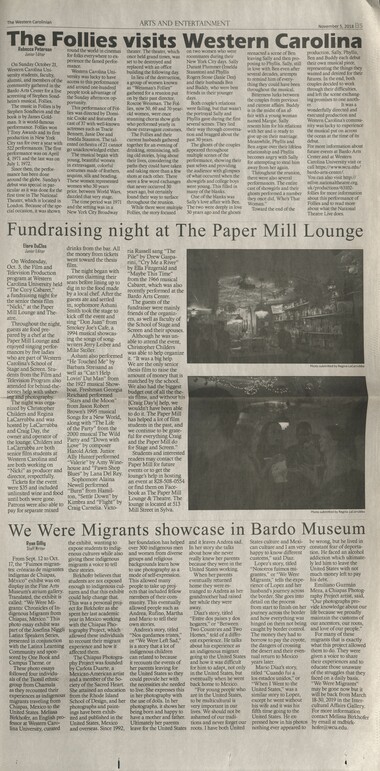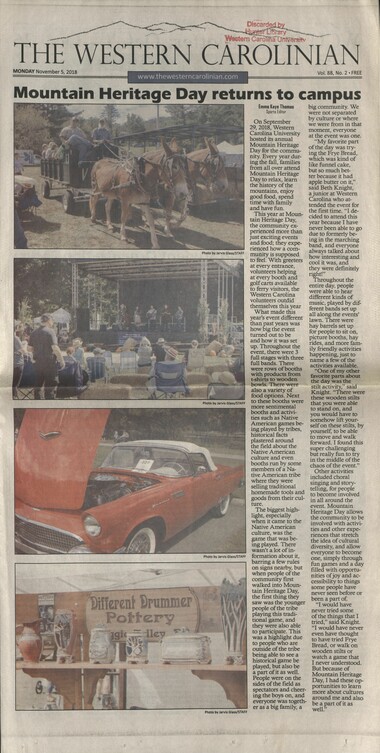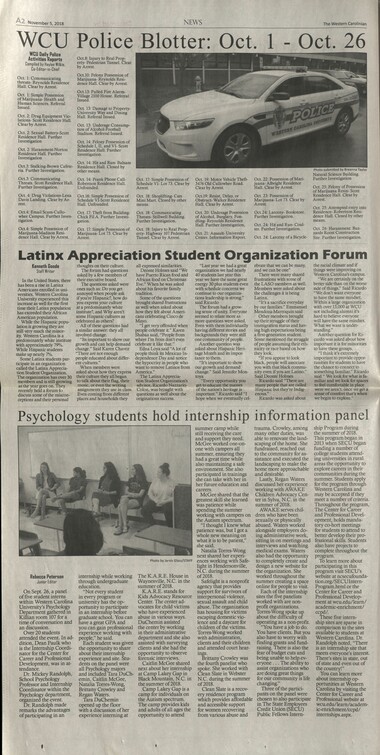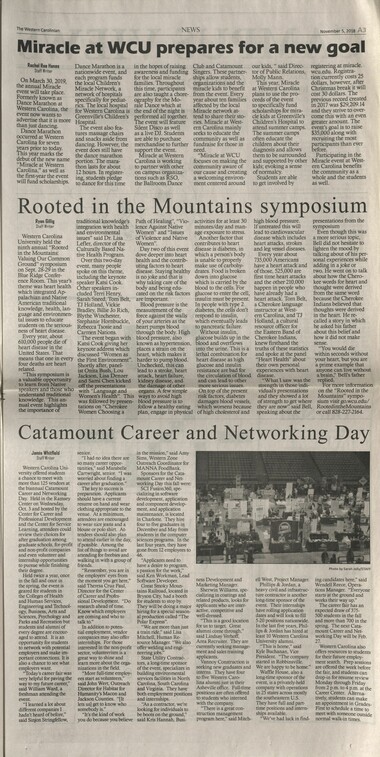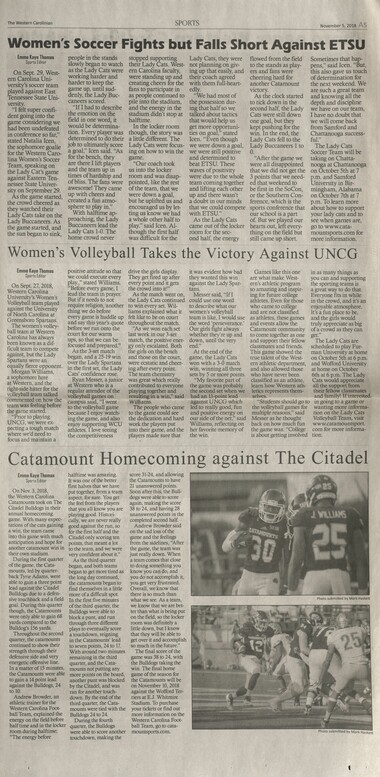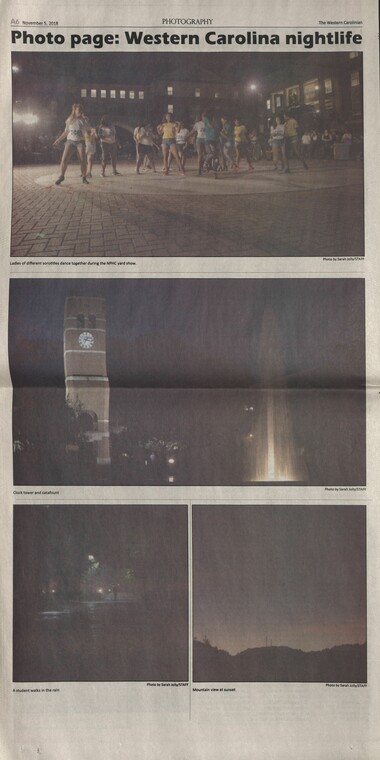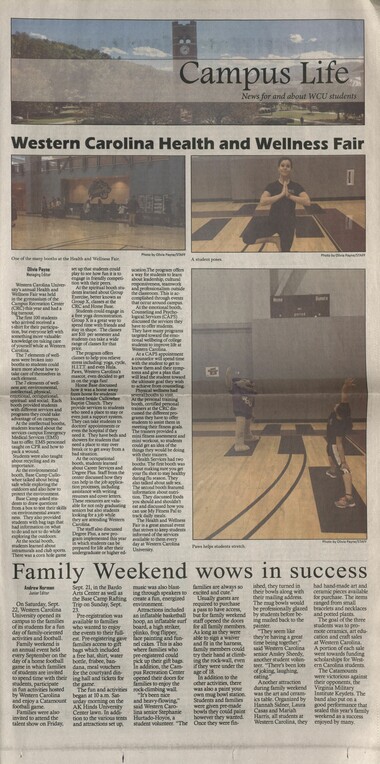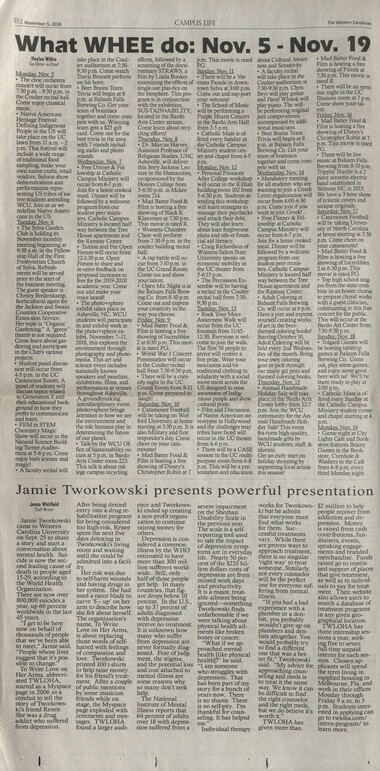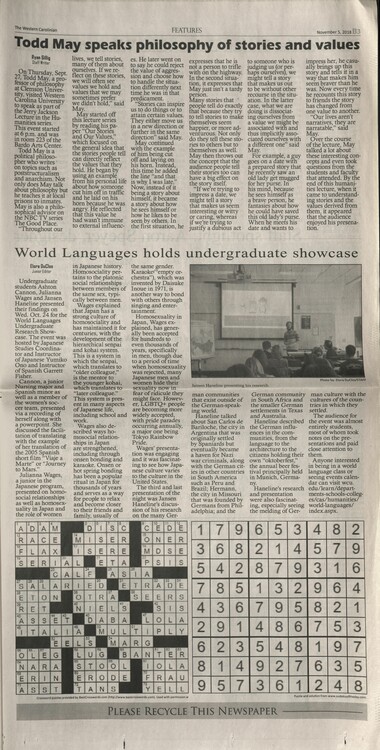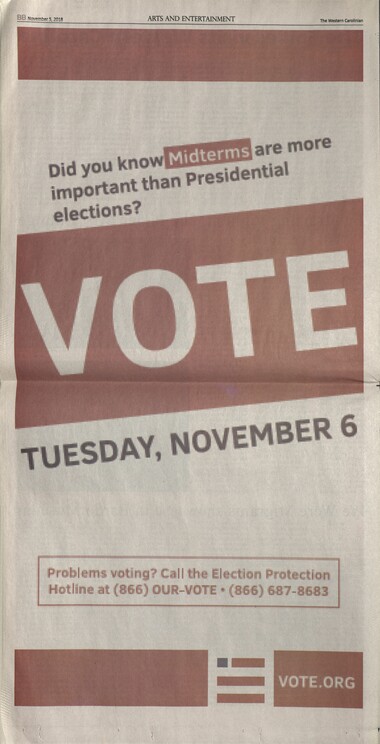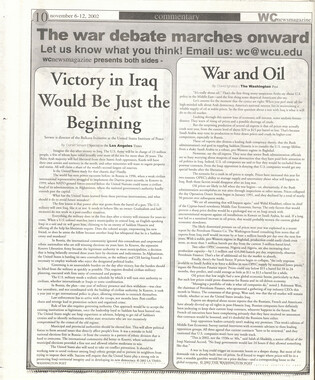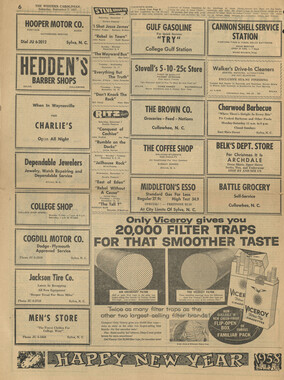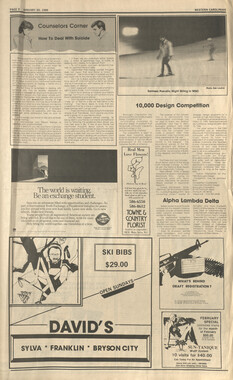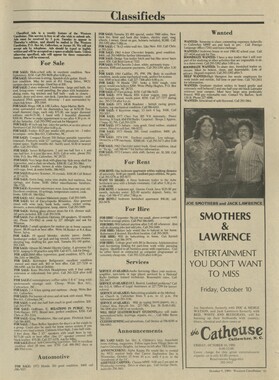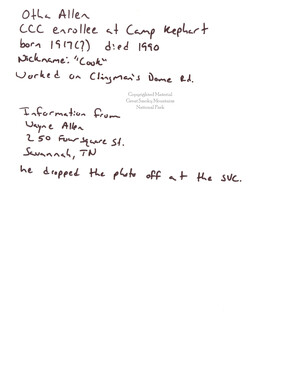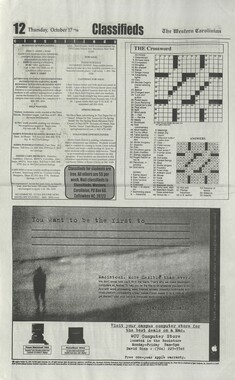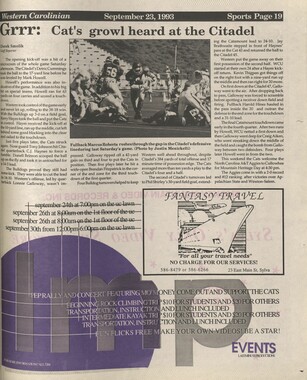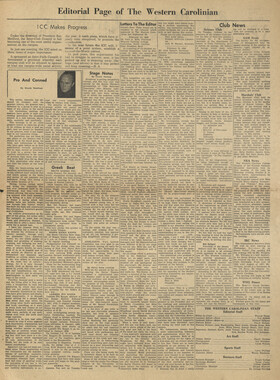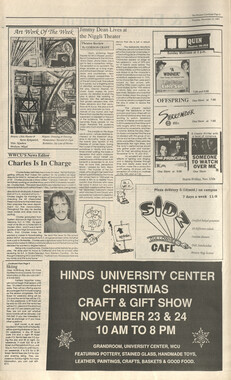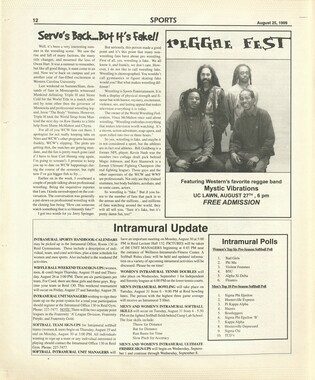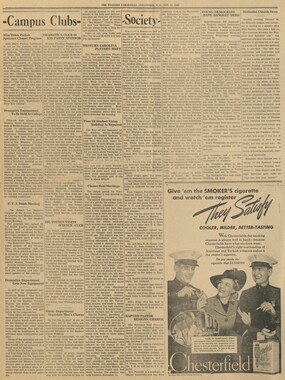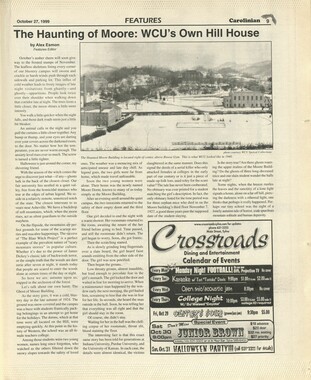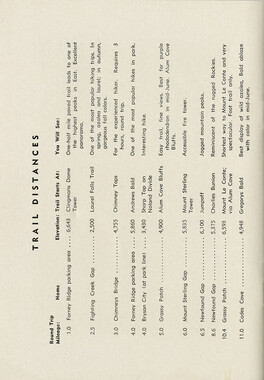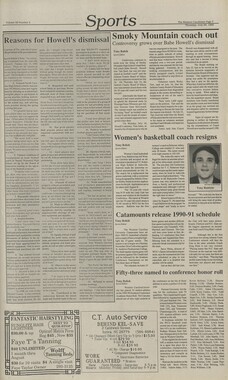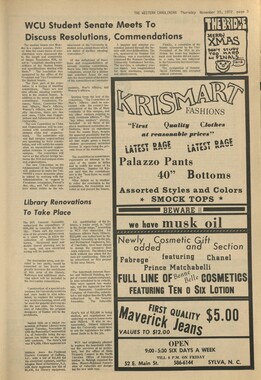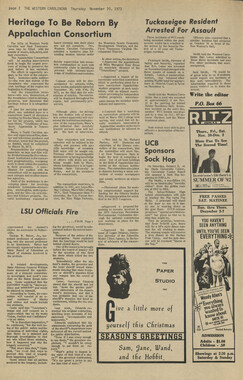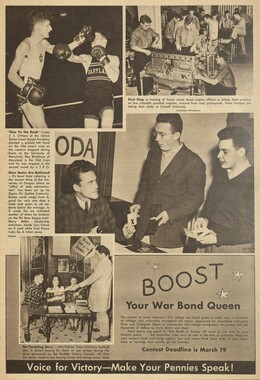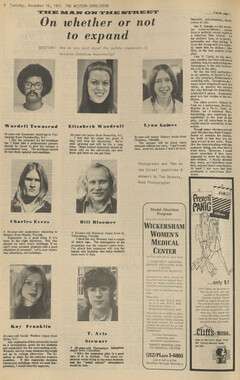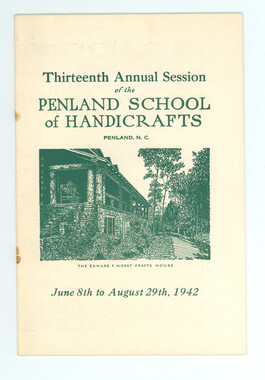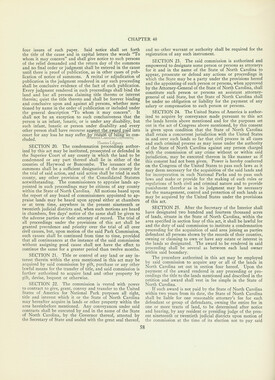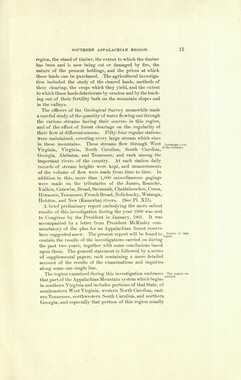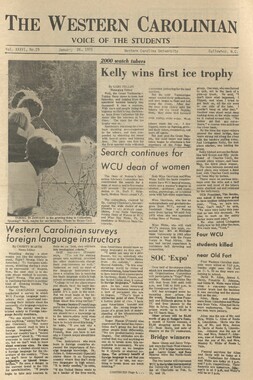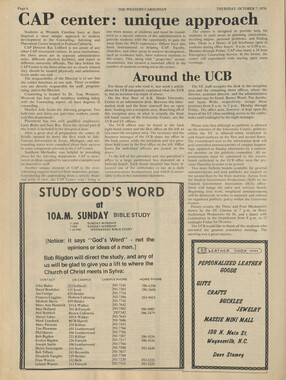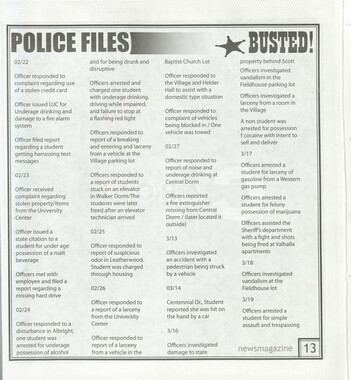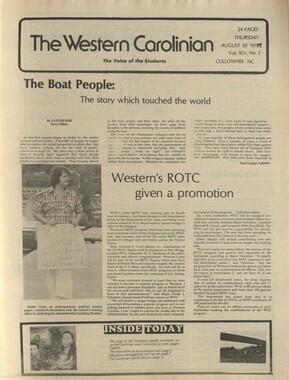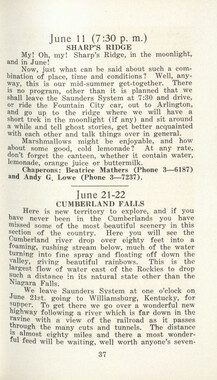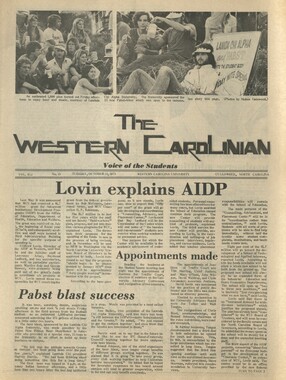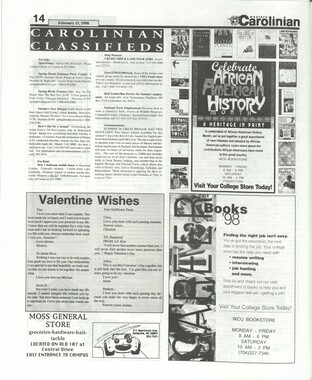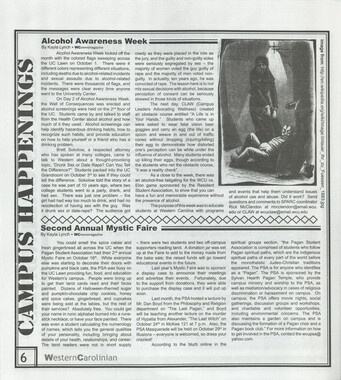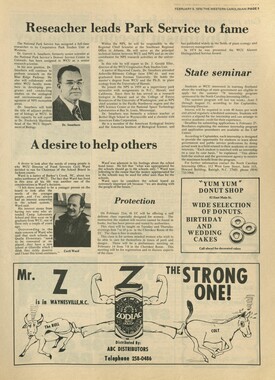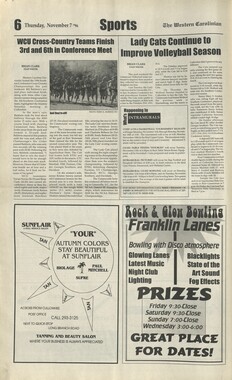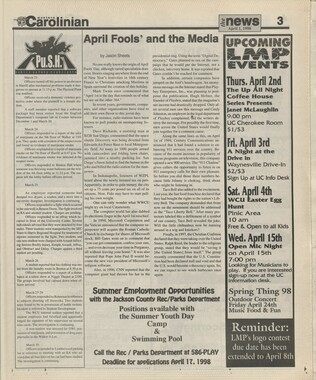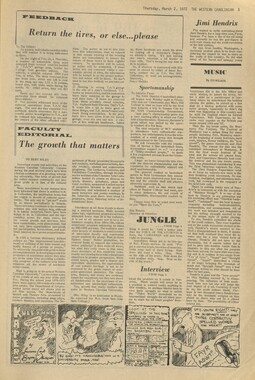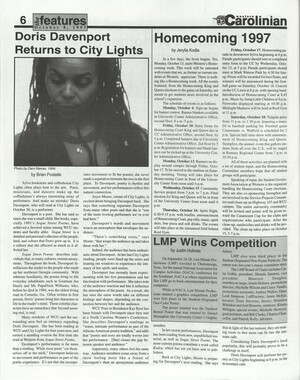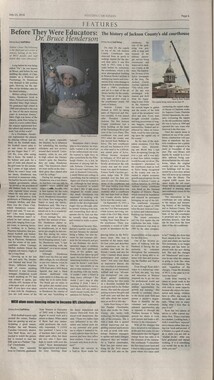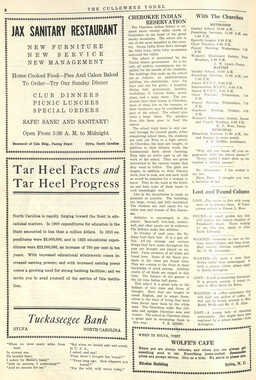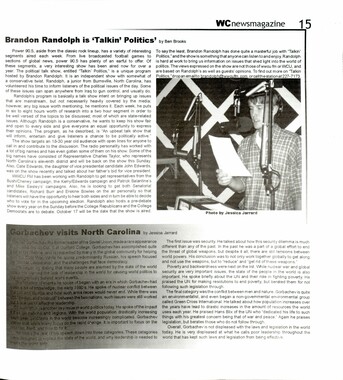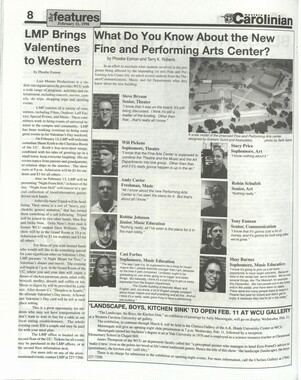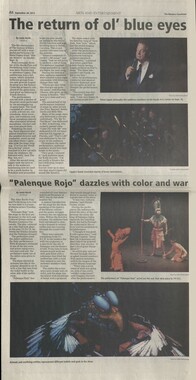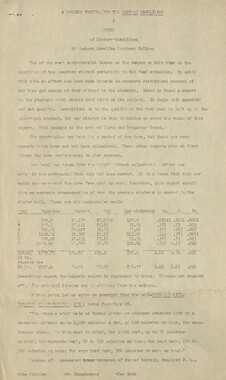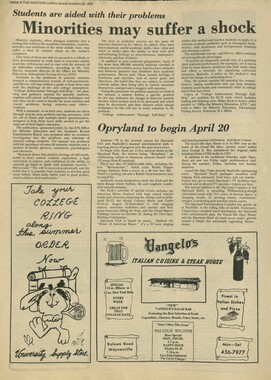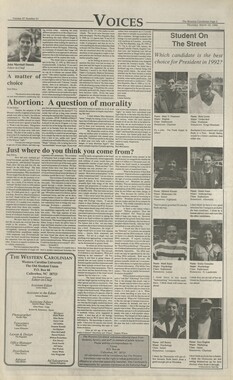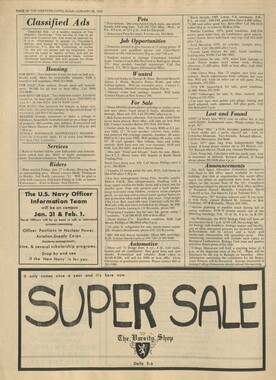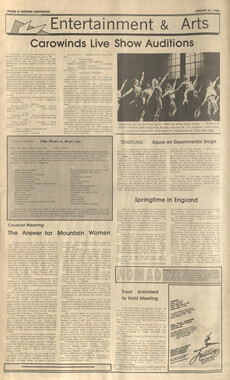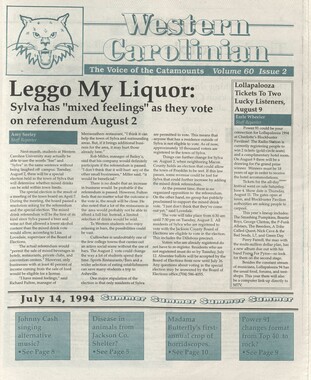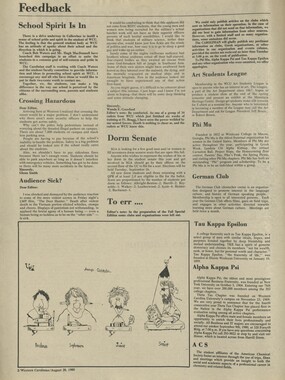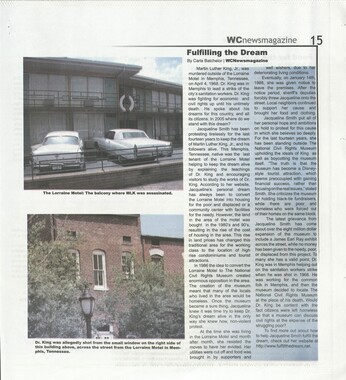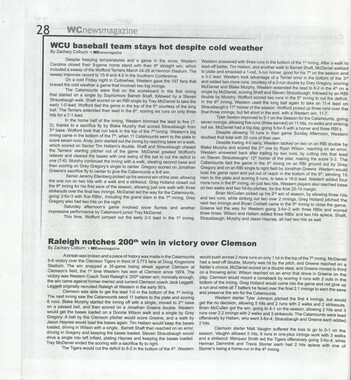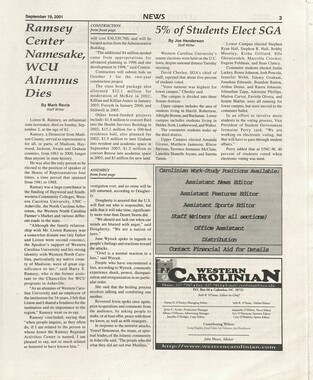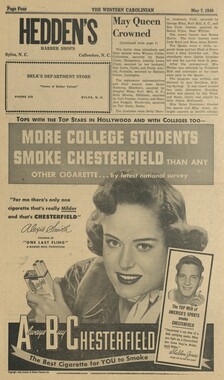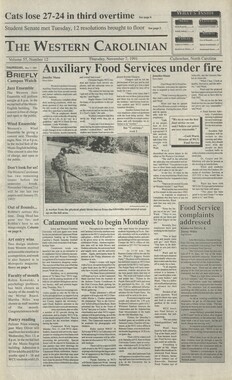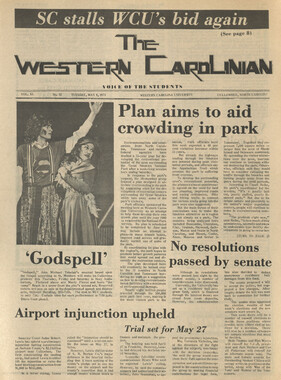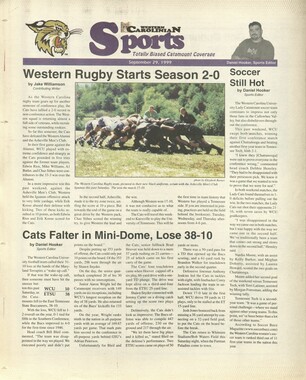Western Carolina University (21)
View all
- Canton Champion Fibre Company (2308)
- Cherokee Traditions (291)
- Civil War in Southern Appalachia (165)
- Craft Revival (1942)
- George Masa Collection (137)
- Great Smoky Mountains - A Park for America (3080)
- Highlights from Western Carolina University (422)
- Horace Kephart (973)
- Journeys Through Jackson (159)
- LGBTQIA+ Archive of Jackson County (89)
- Oral Histories of Western North Carolina (318)
- Picturing Appalachia (6617)
- Stories of Mountain Folk (413)
- Travel Western North Carolina (153)
- Western Carolina University Fine Art Museum Vitreograph Collection (129)
- Western Carolina University Herbarium (92)
- Western Carolina University: Making Memories (738)
- Western Carolina University Publications (2491)
- Western Carolina University Restricted Electronic Theses and Dissertations (146)
- Western North Carolina Regional Maps (71)
- World War II in Southern Appalachia (131)
University of North Carolina Asheville (6)
View all
- Allanstand Cottage Industries (62)
- Appalachian National Park Association (53)
- Bennett, Kelly, 1890-1974 (1463)
- Berry, Walter (76)
- Brasstown Carvers (40)
- Carver, George Washington, 1864?-1943 (26)
- Cathey, Joseph, 1803-1874 (1)
- Champion Fibre Company (233)
- Champion Paper and Fibre Company (297)
- Cherokee Indian Fair Association (16)
- Cherokee Language Program (22)
- Crowe, Amanda (40)
- Edmonston, Thomas Benton, 1842-1907 (7)
- Ensley, A. L. (Abraham Lincoln), 1865-1948 (275)
- Fromer, Irving Rhodes, 1913-1994 (70)
- George Butz (BFS 1907) (46)
- Goodrich, Frances Louisa (120)
- Grant, George Alexander, 1891-1964 (96)
- Heard, Marian Gladys (60)
- Kephart, Calvin, 1883-1969 (15)
- Kephart, Horace, 1862-1931 (313)
- Kephart, Laura, 1862-1954 (67)
- Laney, Gideon Thomas, 1889-1976 (439)
- Masa, George, 1881-1933 (61)
- McElhinney, William Julian, 1896-1953 (44)
- Niggli, Josephina, 1910-1983 (10)
- North Carolina Park Commission (105)
- Osborne, Kezia Stradley (9)
- Owens, Samuel Robert, 1918-1995 (11)
- Penland Weavers and Potters (36)
- Roberts, Vivienne (15)
- Roth, Albert, 1890-1974 (142)
- Schenck, Carl Alwin, 1868-1955 (1)
- Sherrill's Photography Studio (2565)
- Southern Highland Handicraft Guild (127)
- Southern Highlanders, Inc. (71)
- Stalcup, Jesse Bryson (46)
- Stearns, I. K. (213)
- Thompson, James Edward, 1880-1976 (226)
- United States. Indian Arts and Crafts Board (130)
- USFS (683)
- Vance, Zebulon Baird, 1830-1894 (1)
- Weaver, Zebulon, 1872-1948 (58)
- Western Carolina College (230)
- Western Carolina Teachers College (282)
- Western Carolina University (2008)
- Western Carolina University. Mountain Heritage Center (18)
- Whitman, Walt, 1819-1892 (10)
- Wilburn, Hiram Coleman, 1880-1967 (73)
- Williams, Isadora (3)
- Cain, Doreyl Ammons (0)
- Crittenden, Lorraine (0)
- Rhodes, Judy (0)
- Smith, Edward Clark (0)
- Appalachian Region, Southern (3032)
- Asheville (N.C.) (1945)
- Avery County (N.C.) (26)
- Blount County (Tenn.) (195)
- Buncombe County (N.C.) (1680)
- Cherokee County (N.C.) (283)
- Clay County (N.C.) (556)
- Graham County (N.C.) (238)
- Great Smoky Mountains National Park (N.C. and Tenn.) (525)
- Haywood County (N.C.) (3573)
- Henderson County (N.C.) (70)
- Jackson County (N.C.) (4925)
- Knox County (Tenn.) (35)
- Knoxville (Tenn.) (13)
- Lake Santeetlah (N.C.) (10)
- Macon County (N.C.) (421)
- Madison County (N.C.) (216)
- McDowell County (N.C.) (39)
- Mitchell County (N.C.) (135)
- Polk County (N.C.) (35)
- Qualla Boundary (982)
- Rutherford County (N.C.) (78)
- Swain County (N.C.) (2185)
- Transylvania County (N.C.) (270)
- Watauga County (N.C.) (12)
- Waynesville (N.C.) (86)
- Yancey County (N.C.) (72)
- Aerial Photographs (3)
- Aerial Views (60)
- Albums (books) (4)
- Articles (1)
- Artifacts (object Genre) (228)
- Bibliographies (1)
- Biography (general Genre) (2)
- Cards (information Artifacts) (38)
- Clippings (information Artifacts) (192)
- Copybooks (instructional Materials) (3)
- Crafts (art Genres) (622)
- Depictions (visual Works) (21)
- Design Drawings (1)
- Digital Moving Image Formats (2)
- Drawings (visual Works) (185)
- Envelopes (101)
- Exhibitions (events) (1)
- Facsimiles (reproductions) (1)
- Fiction (general Genre) (4)
- Financial Records (12)
- Fliers (printed Matter) (67)
- Glass Plate Negatives (381)
- Guidebooks (2)
- Internegatives (10)
- Interviews (823)
- Land Surveys (102)
- Letters (correspondence) (1045)
- Manuscripts (documents) (618)
- Maps (documents) (177)
- Memorandums (25)
- Minutes (administrative Records) (59)
- Negatives (photographs) (6090)
- Newsletters (1290)
- Newspapers (2)
- Notebooks (8)
- Occupation Currency (1)
- Paintings (visual Works) (1)
- Pen And Ink Drawings (1)
- Periodicals (194)
- Personal Narratives (10)
- Photographs (12977)
- Plans (maps) (1)
- Poetry (6)
- Portraits (4568)
- Postcards (329)
- Programs (documents) (181)
- Publications (documents) (2444)
- Questionnaires (65)
- Relief Prints (26)
- Sayings (literary Genre) (1)
- Scrapbooks (282)
- Sheet Music (2)
- Slides (photographs) (402)
- Songs (musical Compositions) (2)
- Sound Recordings (802)
- Specimens (92)
- Speeches (documents) (18)
- Tintypes (photographs) (8)
- Transcripts (329)
- Text Messages (0)
- A.L. Ensley Collection (275)
- Appalachian Industrial School Records (7)
- Appalachian National Park Association Records (336)
- Axley-Meroney Collection (2)
- Bayard Wootten Photograph Collection (20)
- Bethel Rural Community Organization Collection (7)
- Blumer Collection (5)
- C.W. Slagle Collection (20)
- Canton Area Historical Museum (2110)
- Carlos C. Campbell Collection (462)
- Cataloochee History Project (64)
- Cherokee Studies Collection (4)
- Daisy Dame Photograph Album (5)
- Daniel Boone VI Collection (1)
- Doris Ulmann Photograph Collection (112)
- Elizabeth H. Lasley Collection (1)
- Elizabeth Woolworth Szold Fleharty Collection (4)
- Frank Fry Collection (95)
- George Masa Collection (173)
- Gideon Laney Collection (452)
- Hazel Scarborough Collection (2)
- Hiram C. Wilburn Papers (28)
- Historic Photographs Collection (236)
- Horace Kephart Collection (861)
- Humbard Collection (33)
- Hunter and Weaver Families Collection (1)
- I. D. Blumenthal Collection (4)
- Isadora Williams Collection (4)
- Jesse Bryson Stalcup Collection (47)
- Jim Thompson Collection (224)
- John B. Battle Collection (7)
- John C. Campbell Folk School Records (80)
- John Parris Collection (6)
- Judaculla Rock project (2)
- Kelly Bennett Collection (1482)
- Love Family Papers (11)
- Major Wiley Parris Civil War Letters (3)
- Map Collection (12)
- McFee-Misemer Civil War Letters (34)
- Mountain Heritage Center Collection (4)
- Norburn - Robertson - Thomson Families Collection (44)
- Pauline Hood Collection (7)
- Pre-Guild Collection (2)
- Qualla Arts and Crafts Mutual Collection (12)
- R.A. Romanes Collection (681)
- Rosser H. Taylor Collection (1)
- Samuel Robert Owens Collection (94)
- Sara Madison Collection (144)
- Sherrill Studio Photo Collection (2558)
- Smoky Mountains Hiking Club Collection (616)
- Stories of Mountain Folk - Radio Programs (374)
- The Reporter, Western Carolina University (510)
- Venoy and Elizabeth Reed Collection (16)
- WCU Gender and Sexuality Oral History Project (36)
- WCU Mountain Heritage Center Oral Histories (25)
- WCU Oral History Collection - Mountain People, Mountain Lives (71)
- WCU Students Newspapers Collection (1923)
- Western North Carolina Tomorrow Black Oral History Project (69)
- William Williams Stringfield Collection (2)
- Zebulon Weaver Collection (109)
- African Americans (390)
- Appalachian Trail (35)
- Artisans (521)
- Cherokee art (84)
- Cherokee artists -- North Carolina (10)
- Cherokee language (21)
- Cherokee pottery (101)
- Cherokee women (208)
- Church buildings (190)
- Civilian Conservation Corps (U.S.) (111)
- College student newspapers and periodicals (2012)
- Dams (108)
- Dance (1023)
- Education (222)
- Floods (63)
- Folk music (1015)
- Forced removal, 1813-1903 (2)
- Forest conservation (220)
- Forests and forestry (1198)
- Gender nonconformity (4)
- Great Smoky Mountains National Park (N.C. and Tenn.) (181)
- Hunting (47)
- Landscape photography (25)
- Logging (122)
- Maps (83)
- Mines and mineral resources (9)
- North Carolina -- Maps (18)
- Paper industry (38)
- Postcards (255)
- Pottery (135)
- Railroad trains (72)
- Rural electrification -- North Carolina, Western (3)
- School integration -- Southern States (2)
- Segregation -- North Carolina, Western (5)
- Slavery (5)
- Sports (452)
- Storytelling (243)
- Waterfalls -- Great Smoky Mountains (N.C. and Tenn.) (66)
- Weaving -- Appalachian Region, Southern (280)
- Wood-carving -- Appalachian Region, Southern (328)
- World War, 1939-1945 (173)
Western Carolinian Volume 88 Number 02
Item
Item’s are ‘child’ level descriptions to ‘parent’ objects, (e.g. one page of a whole book).
-
-
The Western Carolinian The F Rebecca Peterson Junior Editor On Sunday October 21, Western Carolina Uni- versity students, faculty, alumni, and members of the community gathered in the Bardo Arts Center for a live screening of Stephen Sond- heims musical, Follies. The music in Follies is by Stephen Sondheim and the book is by James Gold- man. It is world-famous performance. Follies won 7 Tony Awards and its first production in New York City ran for over a year with 522 performances. The first performance was on April 4, 1971 and the last was on July 1, 1972. Since then, the perfor- mance has been done around the globe. Sundays debut was special in par- ticular as it was done for the first time in The National Theater, which is located in London. Because of the spe- cial occasion, it was shown Elora DuClos Junior Editor On Wednesday, Oct. 3, the Film and Television Production program at Western - Carolina University held The Cozy Cabaret, a fundraising night for the senior thesis film Nicki, at the Paper Mill Lounge and The- atre. Throughout the night, guests ate food pre- pared by a chef at the Paper Mill Lounge and enjoyed singing perfor- mances by five ladies who are part of Western Carolinas School of Stage and Screen. Stu- dents from the Film and Television Program also attended for behind-the- scenes help with usher- ing and photography. The night was orga- nized by Christopher Childers and Regina LaCarrubba and was hosted by LaCarrubba and Craig Day, the owner and operator of the lounge. Childers and LaCarrubba are both senior film students at Western Carolina and are both working on Nicki as producer and director, respectfully. Tickets for the event were $35 and included unlimited wine and food until both were gone. Patrons were also able to pay for separate mixed ARTS AND ENTERTAINMENT November 5, 2018 BS ollies visits Western Carolina round the world in cinemas for folks everywhere to ex- perience the famed perfor- mance. Western Carolina Uni- versity was lucky to have access to this performance and around one-hundred people took advantage of the Sunday afternoon op- portunity. This performance of Fol- lies was directed by Domi- nic Cooke and featured a cast of 37 with well-known actresses such as Tracie Bennett, Janie Dee and Imelda Staunton. The tal- ented orchestra of 21 cannot go unacknowledged either. The musical began with young, beautiful women in extravagant, colorful costumes made of feathers, sequins, silk and beading. These women represented women who 30 years prior, between World Wars, dazzled that very stage. The time period was 1971 and the setting was ina New York City Broadway drinks from the bar. All the money from tickets went toward the thesis film. The night began with patrons claiming their seats before lining up to dig in to the food made by a local chef. After the guests ate and settled in, sophomore Ashani Smith took the stage to kick off the event and sing Don Juan from Smokey Joes Cafe, a 1994 musical showcas- ing the songs of song- writers Jerry Leiber and Mike Stoller. Ashani also performed He Touched Me by Barbara Streisand as well as Cant Help Lovin Dat Man from the 1927 musical Show- boat. Freshman Georgia Reichard performed Stars and the Moon | from Jason Robert Browns 1995 musical Songs for a New World, along with The Life of the Party from the 2000 musical The Wild Party and Down with Love by composer Harold Arlen. Junior Ally Hunter performed Valerie by Amy Wine- house and Pawn Shop Blues by Lana Del Rey. Sophomore Alaina Newell performed Burn from Hamil- ton, Settle Down by Kimbra and Flight by Craig Carnelia. Victo- theater. The theater, which once held grand times, was set to be destroyed and replaced with an office building the following day. In lieu of the destruction, a group of women known as Weismans Follies gathered for a reunion put on by their past director, Roscoe Weisman. The Fol- lies, now 50, 60 and 70-year- old women, were once stunning chorus show girls who performed yearly in those extravagant costumes. The Follies and their current husbands gathered together for an evening of drinking, reminiscing, tell- ing old stories, lying about their lives, considering the paths they could have taken and taking more than a few shots at each other. There were a few word exchanges that never occurred 30 years ago, but certainly found their way to surface throughout the reunion. While there were multiple Follies, the story focused ria Russell sang The Pile by Drew Gaspa- rini, Cry Me a River by Ella Fitzgerald and Maybe This Time from the 1966 musical Cabaret, which was also recently performed at the Bardo Arts Center. The guests of the fundraiser were mainly friends of the organiz- ers, as well as faculty of the School of Stage and Screen and their spouses. Although he was un- able to attend the event, Christopher Childers was able to help organize it. It was a big help. We are the only senior thesis film to raise the amount of money that is matched by the school. We also had the biggest budget out of all the the- sis films, and without his [Craig Days] help, we wouldnt have been able to do it. The Paper Mill has helped a lot of film students in the past, and we continue to be grate- ful for everything Craig and the Paper Mill do for Stage and Screen. Students and interested readers may contact the Paper Mill for future events or to get the lounges help in hosting an event at 828-508-0554 or find them on Face- book as The Paper Mill Lounge & Theatre. The lounge is located at 513 Mill Street in Sylva. on two women who were roommates during their New York City days. Sally Durant Plummer (Imelda Staunton) and Phyllis Rogers Stone (Janie Dee) and their husbands Ben and Buddy, who were best friends in their younger days. Both couples relations were failing, but that wasnt the portrayal Sally and Phyllis gave during the first several scenes. They lied their way through conversa- tion and bragged about the past 30 years. The ghosts of the couples appeared throughout multiple scenes of the performance, showing their past selves and providing the audience with glimpses of what occurred when the showgirls and college boys were young. This filled in many of the blanks. One of the blanks was Sallys love affair with Ben. The two were deeply in love 30 years ago and the ghosts reenacted a scene of Ben leaving Sally and then pro- posing to Phyllis. Sally, still in love with Ben even after several decades, attempts to remind him of every- thing they could have been throughout the musical. Bitterness lurks between the couples from previous and current affairs. Buddy is in the midst of an af- fair with a young woman named Margie. Sally resents him for his relations with her and is ready to give up on their marriage. Meanwhile, Phyllis and Ben argue over their lifeless relationship and Phyllis becomes angry with Sally for attempting to steal him away from her again. Throughout the reunion, there were also several performances. The entire cast of showgirls and their ghosts performed a number they once did, Whos That Woman. Toward the end of the production, Sally, Phyllis, Ben and Buddy each debut their own musical piece, representing the things they wanted and desired for their futures. In the end, both couples decided to work through their difficulties, and left the scene exchang- ing promises to one anoth- er. It was a wonderfully directed and executed production and Western Carolinas commu- nity was lucky to experience the musical put on across the ocean at the time of its debut. For more information about future events at Bardo Arts Center and at Western Carolina University visit or call https://www.wcu.edu/ bardo-arts-center/. You can also visit http:// ntlive.nationaltheatre.org. uk/productions/63102- follies for more information about this performance of Follies and to read more about what the National Theatre Live does. Photo submitted by Regina LaCarrubba Photo submitted by Regina LaCarrubba We Were Migrants showcase in Bardo Museum Ryan Gillig Staff Writer From Sept. 12 to Oct. 17, the Fuimos migran- tes: cronicas de migrantes indigenas de Chiapas, Mxico exhibit was on display in the Fine Arts Museums atrium gallery. Translated, the exhibit is called: We Were Mi- grants: Chronicles of In- digenous Migrants from Chiapas, Mxico. This photo essay exhibit was part of the Josefina Niggli Latinx Speakers Series, presented in conjunction with the Latinx Learning Community and spon- sored by One Book and Campus Theme. or These photo essays followed four individu- als of the Tsotsil ethnic group from Chamula as they recounted their experiences as indigenous migrants traveling from Chiapas, Mexico to the United States. Melissa Birkhofer, an English pro- fessor at Western Caro- lina University, curated the exhibit, wanting to expose students to indig- enous cultures while also giving these indigenous migrants a voice to tell their stories. Birkhofer believes that students are not exposed. enough to indigenous cul- tures and that this exhibit could help change that. This was a personal proj- ect for Birkhofer as she spent her last academic year in Mexico working with the Chiapas Pho- tography Project, which allowed these individuals to recount their migrant experience and how it affected them. The Chiapas Photogra- phy Project was founded by Carlota Duarte, a Mexican-American artist and a member of the So- ciety of the Sacred Heart. She attained an education from the Rhode Island School of Design, and her photographs and paint- ings have been exhib- ited and published in the United States, Mexico and overseas. Since 1992, her foundation has helped over 300 indigenous men and women from diverse groups and religious backgrounds learn how to use photography as a mode of self-expression. This allowed many people to take up proj- ects that included fellow members of their com- munity. This eventually allowed people such as Andrea, Rufino, Martha and Mario to tell their own stories. Andreas story, titled Nos quedamos tristes, or We Were Left Sad, is a story that a lot of indigenous children can related to because it recounts the events of her parents leaving for the United States so they could provide her with the necessities she needed to live. She expresses this in her photography with the use of dolls. In her photographs, it shows her being born and happy to have a mother and father. Ultimately her parents leave for the United States and it leaves Andrea sad. In her story she talks about how she never really knew her parents because they were in the United States working. When her parents eventually returned home they were es- tranged to Andrea as her grandmother had raised her while they were away. Diazs story, titled Entre dos paises y dos hogares, or Between Two Countries and Two Homes, told of a differ- ent experience. He talks about his experience as an indigenous migrant going to the United States and how it was difficult for him to adapt, not only in the United States, but eventually when he went back home to Mexico. For young people who are in the United States, to be multicultural is very important in our lives. We should not be ashamed of our tradi- tions and never forget our roots. I have both United States culture and Mexi- can culture and I am very happy to know different customs, said Diaz. Lopezs story, titled Nosotros fuimos mi- grantes, or We Were Migrants, tells the expe- rience of Lopez and her husbands journey across the border. She goes into detail on the process from start to finish on her journey across the border and how everything was hinged on them not being caught by border control. The money they had to borrow to pay the coyote, the dangers of crossing the desert and their even- tual return to Mexico years later. Mario Diazs story, titled Cuando fui a los estados unidos, or When I Went to the United States, was a similar story to Lopez, except he went without his wife and it was his fifth time going to the United States. He ex- pressed how in his photos nothing ever appeared to be wrong, but he lived in constant fear of deporta- tion. He faced an alcohol addiction which ultimate- ly led him to leave the United States with not much money left to pay his debt. Emiliano Guzman Meza, a Chiapas Photog- raphy Project artist, said, Our photographs pro- vide knowledge about our life because we proudly maintain the customs of our ancestors, our roots, and love of our people. For many of these migrants that is exactly what this project allowed them to do. They were given a voice to share their experiences and to educate those unaware of the struggles that they faced on a daily basis. We Were Migrants may be gone now but it will be back from March 18-30, 2019 in the Inter- cultural Affairs Gallery. For more information contact Melissa Birkhofer by email at mdbirk- hofer@wcu.edu.
Object
Object’s are ‘parent’ level descriptions to ‘children’ items, (e.g. a book with pages).
-
The Western Carolinian is Western Carolina University's student-run newspaper. The paper was published as the Cullowhee Yodel from 1924 to 1931 before changing its name to The Western Carolinian in 1933.
-
